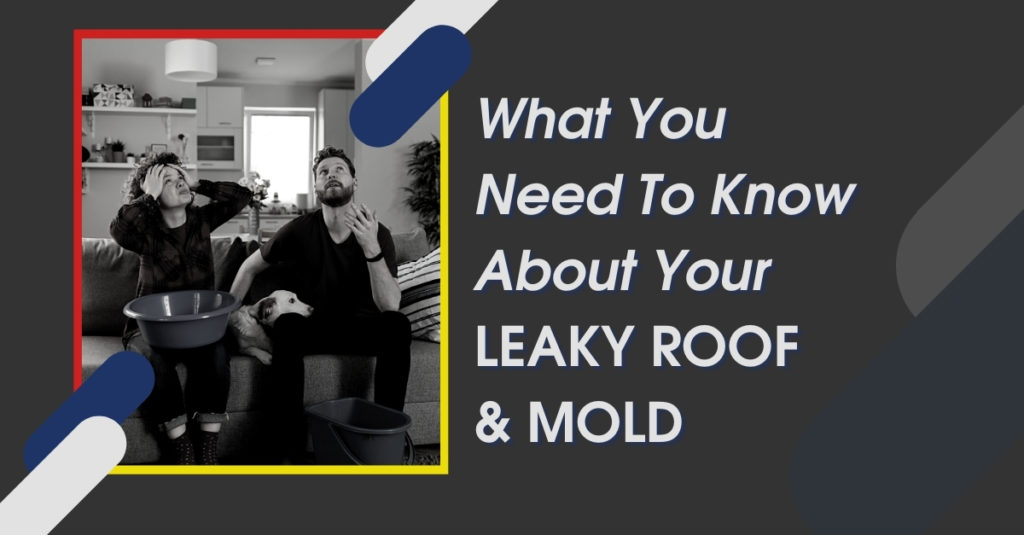Many homeowners assume a leaky roof only causes structural problems. Other than ruining your ceiling, wallpaper, underlayment, and other interior components of your home, a leaky roof poses a number of safety and health risks as well. Constant water intrusion will slowly promote rapid mold growth, which, in turn, can lead to serious health issues.
To prevent such devastating water damage and mold growth, you need to address roof leaks as soon as possible to prevent costly roof replacements in the future.
Signs Your Roof Could Be Leaking
Here are some common signs your roof is springing in leaks:
Water Stains
If you notice a large puddle on your ceiling, sometimes ringed with brown, you could be having a roof leak. Some stains may occur in darker corners, making them difficult to notice, while others might seem tiny yet could be a sign of much larger leaks. Furthermore, water stains are often associated with mold and mildew growth.
Water is Dripping
Sometimes, roof leaks can trigger obvious water drips in the interior of your house whenever it rains or snows. Even if the leak seems to disappear after some time, you still need to have a professional roofer look at it. You could be having an ice dam caused by freezing and thawing of defrosting ice and snow.
Spots On Walls
Every so often, assess your roof from under the roofline outdoors. If you see water spots under there, you could be having trouble where the walls intersect the roof. Water spots in this area can point to issues with your flashing.
Walls are Growing Moss
Check on your exterior wall to see if it’s mossy or moldy. Although exterior walls located in a less-than-sunny spot can develop mold and moss growth, it could also point to a problem with your gutters and downspouts. They form a critical part of your roofing system as they channel water away from your home.
When they begin to leak, you may notice signs of erosion below the gutters and moisture on the sides of your exterior walls.
See Missing Shingles
Missing shingles and issues with flashings around chimneys and other roofing intrusions and valleys can cause roof leaks. A roof which is getting patchy is also more vulnerable to leaking. Even if you don’t see leaks from the inside of your home, there could still be gradual leaks into your attic and crawl spaces. Have your roofer inspect the roof and make the necessary repairs before water damage and mold infestation ruin your home.
See Granules in Your Gutters
When you notice granules appearing in your gutter system and downspouts, or tiles balding, it could be a sign your roofing materials are eroding and need close attention. Shingles which have lost granules are usually more susceptible to breaking, cracking, and curling under extreme weather conditions.
What Causes a Roof to Grow Mold
One of the most devastating consequences of a leaky roof is mold and mildew infestation. Mold can quickly spread in your home’s structure, to your HVAC system, and then to the rest of your home through the vents. In the long-term, mold can invade carpets, clothing, furniture, and anything made of organic matter.
Black mold is often the most common type of mold caused by chronic water intrusion. The growth of toxic black mold is rare, but even this type of mold can attack wood framing, ceiling, tiles, floor covering, and walls. Mold is quite difficult to get rid of, so it’s best to prevent it from growing in the first place by promptly addressing leaks.
1. Roof Leaks
A leaking roof creates an avenue for mold to grow in a big rush. When water enters your home and has the chance to sit for some time, mold spores begin to germinate around the moist surface.
2. Old Shingles
Mold requires only two ingredients to thrive: water and a bit of organic matter to feed on, such as old shingles, wood flooring, or carpet. If your shingles are aged, they could lose granules and harbor some organic matter to promote mold growth.
3. Unrepaired Damage
You can’t prevent spores of mold, mildew, and algae from landing on your roof, but you can certainly prevent the growth. The best way to stop mold before they begin to grow is preventative care. By scheduling regular cleanings and maintenance, you can get rid of the algae before it even becomes an issue or gives way to rot, mold, and mildew.
How Long Mold Takes to Set In
According to the Centers for Disease Control and Prevention, mold can begin to grow in as little as 24 to 48 hours after moisture accumulation. It’s because mold spores are ubiquitous and will set in quickly as long as it finds moisture and some organic matter to feed on. More often, mold causes massive damage well before it’s discovered.
Take Action Now!
As you can see, even the slightest roof leak can open doors to a myriad of problems, including mold infestation and the associated health risks. If you notice any sign of roof leak, schedule a professional roofing inspection to help identify the source of the leak and fix the issue as soon as possible. At StormForce, we offer high-quality roof installations, repair, and replacement in Jacksonville, FL. Contact us today for a free inspection and estimate!
